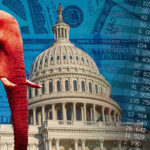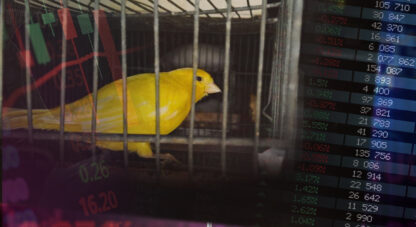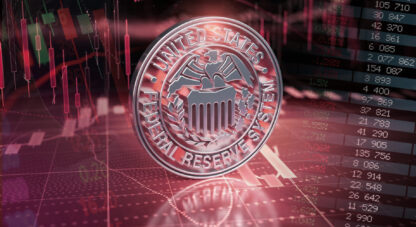I have little confidence history will get this right. Today’s overwhelming consensus view holds that Powell this week committed a major policy blunder. After his early-October “we’re a long way from neutral” “rookie mistake”, he has followed with a rate increase right in the throes of a stock market sell-off, Credit market instability and mounting global and domestic economic risk. He stated the Fed’s balance sheet runoff was stuck on autopilot, even as stunned market participants fret illiquidity. Moreover, Powell disappointed skittish markets heading right into December quadruple-witch options expiration – in the face of an impending government shutdown. How times have changed.
There was irony in Alan Greenspan joining Bloomberg’s Tom Keene Wednesday for live coverage of the FOMC policy decision. It was, after all, the original “Greenspan put” that morphed over Bernanke’s and Yellen’s terms into the interminable “Fed put.” Markets this week were desperate for confirmation that the Powell Fed would uphold the tradition of pacifying the markets and, when needed, invoking the Federal Reserve backstop. Markets were prepared to begrudgingly tolerate a rate increase. But the marketplace demanded evidence – an explicit signal – that the FOMC recognized the gravity of market developments and was prepared to intervene. Chairman Powell didn’t share the markets’ agenda.
Our Federal Reserve Chairman should be commended. Under extraordinary pressure, Mr. Powell and the FOMC didn’t buckle.
Expiration for the aged “Fed put” was long past due. For too long it has been integral to precarious Bubble Dynamics. It has promoted speculation and speculative leverage. It is indispensable to a derivatives complex that too often distorts, exacerbates and redirects risk. The “Fed put” has been integral to momentous market misperceptions, distortions and structural maladjustment. It has been fundamental to the precarious “moneyness of risk assets,” the momentous misconception key to Trillions flowing freely into ETFs and other passive “investment” products and strategies. The “Fed put” was central to a prolonged financial Bubble that over time imparted major structural impairment upon the U.S. Bubble Economy.
Moreover, prolonged U.S. financial and economic Bubbles were fundamental to Bubbles inflating on an unprecedented global scale. The “Fed put” morphed into a disastrous global “policymaker put” phenomenon. If not for the “Fed put,” never would there have been the audaciousness to set forth on “whatever it takes.” And the greater asset Bubbles inflated the more convinced everyone became that central banks and governments (certainly including Beijing!) had everything under control – and would in no terms tolerate a bust.
There is never a good time to pierce a Bubble. There definitely is no cure, so it’s a central banker and policymaker imperative to avoid supporting a backdrop conducive to Bubble Dynamics. There was never going to be a convenient time to end the “Fed put.” Implicit backstops and guarantees are problematic that way. Washington throughout the mortgage finance Bubble period was content with the markets’ view that the Treasury would backstop GSE obligations. No one was willing to rock the boat during the boom. Critical lesson not learned.
As for the Fed’s market “put”, it proved a challenge for Chairman Powell to distance the Federal Open Market Committee (FOMC) from an implicit backstop the Federal Reserve repeatedly employed starting all the way back with the 1987 stock market crash (evolving from liquidity assurances to Trillions of “whatever it takes” liquidity injections and zero rates in a non-crisis backdrop). The new Chairman intimated that he preferred the Fed move in a different direction, subtlety easily lost with the focus on communicating policy continuity. It was only when the markets were under acute pressure that participants would comprehend the seriousness of a subtle but momentous change in the Fed’s approach. That day came Wednesday.
December 21 – CNBC (Kate Rooney): “Federal Reserve Bank of New York President John Williams told CNBC on Friday the Fed is open to reconsidering its views on rate hikes next year. ‘We are listening, there are risks to that outlook that maybe the economy will slow further,’ Williams told Steve Liesman… Williams said despite this week’s forecasts, the central bank is not ‘sitting there saying we know for sure what’s going to happen’ in 2019. ‘What we’re going to be doing going into next year is reassessing our views on the economy, listening to not only markets but everybody that we talk to, looking at all the data and being ready to reassess and re-evaluate our views,’ he said.”
The Dow rallied 350 points in Friday morning trading on comments from (NY Fed President) John Williams. Yet another rally to evaporate. By that time, the damage had been done. Confidence had been shaken. Fear had completely supplanted Greed. And, to be sure, it’s not a market structure especially resistant to waning confidence. Indeed, acute fragilities are being laid bare. Bubbles don’t work in reverse. Crisis Dynamics have engulfed the “Core,” and I’ll leave it at that for this week.
I’ve always had serious issues with central banks promoting the perception that they would eagerly backstop market liquidity. Liquidity is a fundamental market risk – that can’t be permanently transformed, transferred or mitigated. It’s a precarious proposition to promote the belief that contemporary central banks – with unlimited capacity to create liquidity – will do “whatever it takes” to ensure highly liquid markets. Nevertheless, it’s extremely challenging to convey to market participants, central bankers, politicians and the general public why central banks aggressively underpinning the markets over the long-term promotes pernicious instability for the markets, real economies and humanity more generally.
The implicit “Fed put” seemed so innocuous when things looked good – so long as the Bubble was inflating. For going on a decade, Bubble Analysis has appeared a pathetic waste of time. Suddenly, cracks appear, confidence wanes, liquidity disappears, credit falters – and ramifications are anything but subtle: so much teeters on the markets’ perception of the efficacy of central bank market backstops. The world today hangs in the balance – markets, economies, politics and geopolitics. One of the greatest risks associated with the global government finance Bubble has been a crisis of confidence in policymaking.
It was inevitable the “Fed put” would turn problematic. The more explicit central backstops become, the more market distortions promote self-reinforcing speculative excess and Bubbles. The greater the scope of Bubbles, the more deeply manic markets become convinced that central bankers won’t allow the good times to end. Importantly, speculation and leverage will invariably expand beyond the expected capacity of liquidity backstops. This is why “whatever it takes” and “QE infinity” were so reckless. There became essentially no degree of excess that troubled the marketplace. It degenerated into a complete malfunctioning of the market mechanism.
I certainly don’t believe the “Fed put” is dead. The Powell Fed just meaningfully lowered the “strike price.” They’ll be forced to respond, but only after the market has suffered significant impairment. To the markets’ horror, the bursting Bubble will pass the point of no return before our central bank is compelled to aggressively defend the marketplace.
As painful as this process will become, and as deeply distressing it will be to see so many hopes, dreams and expectations crushed, the Powell Fed is taking the best approach. The Bubble would have inevitably burst. Indeed, the global Bubble has been deflating since earlier in the year. That the U.S. “Terminal Phase” of Bubble excess continued even as the global Bubble faltered created a perilous divergence that would end badly. It’s ending now – badly. The miserable downside would have only been worse had the Fed stepped in, bolstered the markets once again and extended the “Terminal Phase.”
It would have been the easy decision for Powell to just pull a Greenspan, Bernanke or Yellen. Just give the markets what they want and silence the temper tantrum. The three preceding Fed chairs invariably acted in the interest of sustaining or resuscitating Bubble Dynamics. In my view, at least two of the three seemed preoccupied with their own reputations and legacies.
In an age seemingly bereft of statesmen, Jay Powell is one. He will fall under only more intense pressure and criticism. This good man will be pilloried and blamed for a predicament decades in the making. Clearly, he’s the targeted presidential fall guy. History will surely be merciless, and it’s all unfair. I worry about a lot of things these days, including how our nation will attract talented and decent individuals into public service – especially now that they will be needed more than ever. We’re heading into challenging and unsettling times. Somehow our nation must to come together and support our institutions and responsible public servants.
For the Week:
The S&P500 sank 7.1% (down 9.6% y-t-d), and the Dow fell 6.9% (down 9.2%). The Utilities declined 4.3% (up 1.5%). The Banks fell 6.3% (down 22.7%), and the Broker/Dealers lost 5.7% (down 14.5%). The Transports dropped 6.7% (down 16.4%). The S&P 400 Midcaps fell 7.0% (down 15.2%), and the small cap Russell 2000 sank 8.4% (down 15.9%). The Nasdaq100 fell 8.3% (down 5.5%). The Semiconductors lost 6.5% (down 12.1%). The Biotechs sank 10.9% (down 6.7%). With bullion jumping $17.60, the HUI gold index rose 2.5% (down 18.6%).
Three-month Treasury bill rates ended the week at 2.33%. Two-year government yields declined nine bps to 2.64% (up 76bps y-t-d). Five-year T-note yields fell nine bps to 2.64% (up 43bps). Ten-year Treasury yields dropped 10 bps to 2.79% (up 39bps). Long bond yields fell 11 bps to 3.03% (up 29bps). Benchmark Fannie Mae MBS yields dropped 13 bps to 3.62% (up 63bps).
Greek 10-year yields rose 11 bps to 4.33% (up 26bps y-t-d). Ten-year Portuguese yields increased two bps to 1.69% (down 26bps). Italian 10-year yields dropped 11 bps to 2.83% (up 82bps). Spain’s 10-year yields slipped a basis point to 1.40% (down 17bps). German bund yields were unchanged at 0.25% (down 18bps). French yields declined two bps to 0.70% (down 9bps). The French to German 10-year bond spread narrowed two to 45 bps. U.K. 10-year gilt yields rose eight bps to 1.32% (up 13bps). U.K.’s FTSE equities index declined 1.8% (down 12.6%).
Japan’s Nikkei 225 equities index sank 5.7% (down 11.4% y-t-d). Japanese 10-year “JGB” yields added a basis point to 0.05% (unchanged). France’s CAC40 fell 3.3% (down 11.6%). The German DAX equities index declined 2.1% (down 17.7%). Spain’s IBEX 35 equities index fell 3.7% (down 14.8%). Italy’s FTSE MIB index dropped 2.7% (down 15.8%). EM equities were mixed to lower. Brazil’s Bovespa index declined 2.0% (up 12.2%), while Mexico’s Bolsa added 0.4% (down 16%). South Korea’s Kospi index slipped 0.4% (down 16.5%). India’s Sensex equities index declined 0.6% (up 4.9%). China’s Shanghai Exchange dropped 3.0% (down 23.9%). Turkey’s Borsa Istanbul National 100 index gained 1.5% (down 20.4%). Russia’s MICEX equities index declined 0.8% (up 11.3%).
Investment-grade bond funds saw outflows of $3.927 billion, and junk bond funds posted outflows of $789 million (from Lipper).
Freddie Mac 30-year fixed mortgage rates slipped one basis point to a four-month low 4.62% (up 68bps y-o-y). Fifteen-year rates were unchanged at 4.07% (up 69bps). Five-year hybrid ARM rates fell six bps to 3.98% (up 59bps). Bankrate’s survey of jumbo mortgage borrowing costs had 30-yr fixed rates down 10 bps to a ten-month low 4.46% (up 31bps).
Federal Reserve Credit last week declined $0.5bn to $4.048 TN. Over the past year, Fed Credit contracted $360bn, or 8.2%. Fed Credit inflated $1.237 TN, or 44%, over the past 319 weeks. Elsewhere, Fed holdings for foreign owners of Treasury, Agency Debt recovered $18.7bn last week to $3.403 TN. “Custody holdings” rose $30.5bn y-o-y, or 0.9%.
M2 (narrow) “money” supply jumped $28.5bn last week to a record $14.323 TN. “Narrow money” gained $582bn, or 4.2%, over the past year. For the week, Currency increased $1.3bn. Total Checkable Deposits fell $16.8bn, while Savings Deposits surged $49.2bn. Small Time Deposits gained $4.8bn. Retail Money Funds declined $10.3bn.
Total money market fund assets increased $5.6bn to $3.008 TN. Money Funds gained $187bn y-o-y, or 6.6%.
Total Commercial Paper dropped $15.8bn to $1.074 TN. CP declined $4.4bn y-o-y, or 0.4%.
Currency Watch:
December 17 – Bloomberg (Chris Anstey): “China’s exchange rate is likely to get more volatile in time as the country pushes greater international use of the yuan, according to Goldman Sachs… While the yuan-internationalization campaign hit a setback as China tightened regulation of capital flows in the wake of a messy 2015 devaluation, there’s increasing pressure for policy makers to take up the initiative again, economists including MK Tang wrote… China’s current account will tip into deficit in coming years, in the view of many strategists, as its increasingly large economy continues to grow faster than the rest of the world. In financing that deficit, China could reduce risks if it acquired funding in its own currency — much like the U.S. does now, and unlike more vulnerable countries such as Brazil, Goldman noted.”
The U.S. dollar index declined 0.5% to 96.956 (up 5.2% y-t-d). For the week on the upside, the Japanese yen increased 2.0%, the Mexican peso 1.5%, the South Korean won 0.7%, the euro 0.6%, the British pound 0.5%, the Swiss franc 0.4%, the Brazilian real 0.4%, the Swedish krona 0.2% and the Singapore dollar 0.2%. For the week on the downside, the Australian dollar declined 1.8%, the Norwegian krone 1.7%, the South African rand 1.7%, the Canadian dollar 1.6% and the New Zealand dollar 1.0%. The Chinese renminbi was little changed versus the dollar this week (down 5.79% y-t-d).
Commodities Watch:
The Goldman Sachs Commodities Index sank 6.3% (down 14.0% y-t-d). Spot Gold gained $17.60 to $1,256 (down 3.6%). Silver increased 0.4% to $14.702 (down 14.2%). Crude sank $5.61 to $45.59 (down 25%). Gasoline fell 8.1% (down 27%), and Natural Gas slipped 0.3% (up 29%). Copper dropped 3.2% (down 19%). Wheat fell 3.0% (up 20%). Corn declined 1.6% (up 8%).
Market Dislocation Watch:
December 21 – CNBC (Thomas Franck): “Stocks plunged again on Friday, sending the Dow Jones Industrial Average to its worst week since the financial crisis in 2008, down nearly 7%. The Nasdaq Composite Index closed in a bear market and the S&P 500 was on the brink of one itself, down nearly 18% from its record earlier this year.”
December 16 – Financial Times (Eric Platt, Colby Smith and Joe Rennison): “US credit markets are grinding to a halt with fund managers refusing to bankroll buyouts and investors shunning high-yield bond sales as rising interest rates and market volatility weigh on sentiment. Not a single company has borrowed money through the $1.2tn US high-yield corporate bond market this month. If that drought persists, it would be the first month since November 2008 that not a single high-yield bond priced in the market, according to data providers Informa and Dealogic. In the leveraged loan market, two transactions were postponed last week after Barclays, Deutsche Bank, UBS and Wells Fargo failed to find buyers for the debt packages, a rarity in what has been one of the hottest corners of credit markets this year.”
December 21 – Bloomberg (Davide Scigliuzzo and Sally Bakewell): “A rout in the once-hot market for risky corporate loans has some of Wall Street’s largest banks stuck with at least $1.6 billion of unwanted leveraged buyout debt. Banks including Barclays Plc, Goldman Sachs… and Bank of America… — among the top providers of loans for LBOs — have struggled in recent weeks to sell loans they’ve agreed to make for private equity deals, as concerns about the global economic outlook spurred investors to flee risky assets. At least four loan sales for buyouts and acquisitions have failed to clear the market so far this month, forcing the banks to keep the debt on their books…”
December 17 – Bloomberg (Lisa Lee): “Some of the biggest buyers of company loans are scaling back, and it’s hurting the market for buyout debt. Money managers that buy loans and repackage them into bonds have cut back on their activity. Sales of the rebundled loans, known as collateralized loan obligations, dropped 25% in the first half of December from the same period last year, after falling 10% in November. The firms that issue CLOs buy about half the loans made to junk-rated companies. As demand from these money managers has waned, not to mention buying from retail investors, prices for leveraged loans have reached their lowest levels in more than two years.”
December 15 – New York Times (Matt Phillips): “Stocks? Messy. Bonds? Meh. Commodities? Not pretty. Most years, financial markets are a mixed bag. A bad year for risky investments, like stocks, might be a great one for safe bets like government bonds. Or, if worries about inflation are hurting bond investments, commodities like gold tend to do well. Not this year. For the first time in decades, every major type of investment has fared poorly, as the outlook for economic growth and corporate profits is dampened by rising trade tensions and interest rates. Stocks around the world are getting pummeled, while commodities and bonds are tumbling — all of which have left investors with few places to put their money.”
December 18 – Bloomberg (Donal Griffin, Jennifer Surane and Cathy Chan): “Citigroup Inc. faces losses of as much as $180 million on loans made to an Asian hedge fund whose foreign-exchange wagers went awry, prompting board-level discussions and a business shakeup, according to a person briefed on the matter. The hedge fund, managed by a unit of GF Holdings (Hong Kong) Corp., and Citigroup are in discussions on the positions and how they should be valued… The situation is fluid and the eventual losses may end up being smaller depending on how the trades are unwound, one of the people said.”
Trump Administration Watch:
December 21 – Bloomberg (Daniel Flatley, Erik Wasson, Steven T. Dennis and Laura Litvan): “Parts of the U.S. government began shutting down on Saturday for the third time this year after a bipartisan spending deal collapsed over President Donald Trump’s demands for more money to build a wall along the U.S.-Mexico border. Trump scuttled an agreement that would have kept the government open until February after coming under heavy criticism from conservative talk show hosts and some allies in the House because the measure didn’t include the $5 billion he wanted for the wall. While negotiations to resolve the impasse are underway, it’s not clear whether parts of the government will remain shuttered for days or weeks. Ending the shutdown — which affects nine of 15 federal departments and dozens of agencies — requires Democratic leaders and Trump to reach a compromise, which so far has been elusive as both sides hardened their positions.”
December 18 – Bloomberg (David Lawder): “The United States and China are planning to hold meetings in January to ‘document an agreement’ on trade, U.S. Treasury Secretary Steven Mnuchin told Bloomberg… Mnuchin was quoted as saying the two sides had held several phone conversations in recent weeks, and were planning further formal talks.”
December 18 – Reuters (Susan Heavey): “U.S. President Donald Trump on Tuesday further sought to pressure the Federal Reserve as the central bank prepared to start its two-day policy meeting, warning the Fed’s board not to ‘make yet another mistake’ ahead of an expected interest rate hike… Trump, who has made the economy a key part of his political platform, has repeatedly criticized the Fed and its chairman, Jerome Powell. ‘Don’t let the market become any more illiquid than it already is. Stop with the 50 B’s. Feel the market, don’t just go by meaningless numbers. Good luck!’ Trump wrote.”
December 17 – Wall Street Journal (Alex Leary and Nick Timiraos): “President Trump argued Monday on Twitter that it was ‘incredible’ that Federal Reserve policy members were considering raising interest rates again, continuing his public campaign against tighter monetary policy… ‘It is incredible that with a very strong dollar and virtually no inflation, the outside world blowing up around us, Paris is burning and China way down, the Fed is even considering yet another interest rate hike,’ Mr. Trump tweeted. ‘Take the Victory!’”
December 18 – Bloomberg (Tom Schoenberg, Chris Dolmetsch and Jennifer Epstein): “The U.S. Justice Department announced indictments accusing Chinese officials of coordinating a decade-long espionage campaign to steal intellectual property and other data from dozens of companies, adding to tensions amid the trade war between the two nations. Two Chinese nationals, Zhu Hua and Zhang Shilong, were accused… of coordinating with state security officials in an ‘extensive’ hacking campaign, allegedly infiltrating 45 U.S. companies and government agencies… Secretary of State Michael Pompeo and Homeland Security Secretary Kirstjen Nielsen said… they were ‘concerned’ that the alleged operation violated a 2015 agreement China made with the U.S. to stop supporting cyber theft of intellectual property and trade secrets.”
December 18 – Bloomberg (Saleha Mohsin, Elizabeth Dexheimer and Craig Torres): “The Trump administration wants to work with Congress on freeing Fannie Mae and Freddie Mac from government control, though it’s considering pursuing some changes on its own, Treasury Secretary Steven Mnuchin said… ‘I would like to get them out of conservatorship,’ Mnuchin said during a roundtable interview at Bloomberg’s Washington office. ‘My preference would be to do something that has bipartisan legislative support.’ … Fannie and Freddie have spent more than a decade under the government’s thumb with no end in sight. The U.S. took over the mortgage-finance giants during the 2008 financial crisis, eventually injecting them with $187.5 billion as the housing market tanked. The companies have since become profitable again, and have paid about $279 billion to the U.S. Treasury in dividends that don’t count as repayment.”
Federal Reserve Watch:
December 19 – Financial Times (Sam Fleming): “If bruised US equity investors were expecting Jay Powell to come to their rescue at the final Federal Reserve policy meeting of the year, they were sorely mistaken. The Fed chairman ploughed ahead on Wednesday with the fourth quarter-point interest rate rise in 2018 and brushed aside calls for the central bank to slow its balance sheet reduction programme. Weeks of market volatility had caused financial conditions to tighten only ‘a little bit’, he said at a press conference. The economy, he added, no longer needed any monetary support. The resulting stock market slide — the S&P 500 dropped as much as 2.3%, marking the worst fall following a Fed rate rise since 1994 — will have come as unwelcome news to a central bank that has been an unwitting contributor to volatility in recent months.”
December 16 – Reuters (Howard Schneider): “Whatever the acronym, when the U.S. Federal Reserve dropped its policy rate to near zero on Dec. 16, 2008, to counter a full-scale economic crisis, it ushered in what the central bank’s chairman at the time, Ben Bernanke, called ‘the end of the old regime.’ A decade later, the full impact and import of that move are still not fully clear. But the Fed was never the same. The decision to move to zero ushered in wholesale changes to how the Fed works, from its building a massive balance sheet to adopting an explicit 2% inflation target and holding regular post-meeting press conferences. A new body of research continues to explore the likelihood that trips to the ‘effective lower bound’ will become common.”
December 20 – Bloomberg (Mohamed A. El-Erian): “Resisting unusual pressure from both politicians and notable market participants, Federal Reserve Chairman Jerome Powell and his colleagues on the Open Market Committee on Wednesday raised interest rates by 25 bps and slowed the path for future hikes by less than markets hoped. In doing so, the central bank reaffirmed that its focus remains firmly domestic and economic. But the markets’ reaction suggested the move was seen as heightening concerns about a policy mistake, rather than responsible policy making. This, and what’s likely to play out over the next few weeks, illustrates a bigger phenomenon: the threat that the Fed and other central banks are increasingly in a no-win situation, due to factors mostly outside their control.”
December 18 – Bloomberg (Jeff Kearns): “Selling in U.S. stocks has an ominous historical comparison for Federal Reserve officials debating an interest-rate increase this week. The last time the S&P 500 Index fell this much in the period between two policy gatherings was the collapse of investment bank Lehman Brothers Holdings Inc. in 2008… The S&P 500 has declined 9.3% from the Fed’s last meeting on Nov. 8 through Monday’s close. That’s the biggest intra-meeting slump since the 18.8% plunge between its Sept. 16, 2008, meeting, a day after Lehman filed for bankruptcy, and a special gathering announced on Oct. 8.”
U.S. Bubble Watch:
December 19 – Reuters (Jason Lange): “The U.S. current account deficit increased in the third quarter as imports surged, the Commerce Department said… in a report that also showed U.S. firms brought into the United States $92.7 billion in repatriated earnings. …The current account deficit, which measures the flow of goods, services and investments into and out of the country, widened to $124.8 billion, or 2.4% of national economic output, in the July-September period. Analysts polled by Reuters had expected the current account deficit to widen to $124.3 billion.”
December 18 – CNBC (Bob Pisani): “It’s official: This is an all-time record year for corporate stock buybacks. Announced buybacks for 2018 are now at $1.1 trillion. And companies are using their authorizations. About $800 billion of stock has already been bought back, leaving about $300 billion yet to be purchased. We’ve seen buyback announcements recently from Lowe’s, Pfizer, and Facebook, but in the last few days, as stocks have moved to new lows, companies are picking up the pace of activity.”
December 17 – Reuters (Manojna Maddipatla and Daniel Wiessner): “Shares of U.S. health insurers, hospitals and healthcare companies fell on Monday in the aftermath of a ruling by a federal judge in Texas that the Affordable Care Act (ACA), commonly called Obamacare, was unconstitutional.”
December 17 – Bloomberg (Scott Lanman): “Factories in New York state reported a sharp slowdown in business, sending a Federal Reserve index tumbling this month to a 19-month low and adding to signs U.S. economic growth is moderating. The New York Fed’s Empire State manufacturing index fell 12.4 points to 10.9…”
December 17 – Reuters (Imani Moise): “As U.S. bank stocks tanked this month over fears of an impending recession, industry executives downplayed concerns to colleagues, analysts and journalists, arguing that the economy is in great shape. But looking behind headline numbers showing healthy loan books, problems appear to be cropping up in areas such as home-equity lines of credit, commercial real estate and credit cards, according to federal data reviewed by Reuters. Lenders are also starting to cut relationships with customers who seem too risky.”
December 18 – Wall Street Journal (Corrie Driebusch): “The reign of the unicorn IPO has commenced. Investors gripe that highly valued tech companies are eschewing the public markets and opting to remain private for longer. But in 2018, to little fanfare, 38 tech and internet companies valued at $1 billion or more at the time of their IPO listed shares in the U.S., the most to do so since the height of the dot-com boom in 2000, according to Dealogic. That is expected to rise next year, according to bankers and fund managers who follow the IPO market. In 2019 some of the hottest names among the tech unicorns, including Uber Technologies Inc., Lyft Inc. and Slack Technologies Inc. are considering IPOs.”
December 17 – Bloomberg (Ros Krasny): “The number of Americans expecting the U.S. economy to get worse in the next year is at its highest point since 2013, a national NBC/Wall Street Journal poll shows… Overall, 28% of Americans said the economy will get better in the next year, while 33% predict it will get worse, according to the survey… Those numbers were essentially reversed from January, when 35% said the economy would get better and 20% said it would get worse.”
December 19 – Reuters (Lucia Mutikani): “U.S. home sales unexpectedly rose in November, but recorded their biggest annual decline in 7-1/2 years as the housing market remained mired in weakness amid higher mortgage rates which have made home purchases more expensive… ‘The trend in housing is clearly slowing as affordability takes a bite,’ said Jennifer Lee, a senior economist at BMO Capital Markets… The National Association of Realtors said existing home sales increased 1.9% to a seasonally adjusted annual rate of 5.32 million units last month… Sales have now increased for two straight months.”
December 18 – Bloomberg (Romy Varghese): “States collected more than $1 trillion in tax revenue in fiscal 2018, a record, while the growth rate is unlikely to be sustained, according to… the Tax Policy Center. Tally increased by 7.8% from 2017: Growth in income tax driven by timing decisions responding to the federal tax overhaul passed last December: States still face large fiscal challenges and uncertainties from tax changes…”
China Watch:
December 21 – Bloomberg: “China’s top policy makers confirmed that more monetary and fiscal support will be rolled out in 2019, as the world’s second-largest economy grapples with a slowdown that’s yet to show signs of ending. ‘Significant’ cuts to taxes and fees will be enacted in 2019 and while monetary policy will remain ‘prudent,’ officials will strike an ‘appropriate’ balance between tightening and loosening, according to a statement published after the annual Economic Work Conference… The statement signals that China is ratcheting up the limited, targeted stimulus approach used during 2018, though still stopping short of the all-out support that would pressure the currency and hobble efforts to contain debt.”
December 20 – Wall Street Journal (Nathaniel Taplin): “‘What we should and can reform, we will resolutely reform. What shouldn’t be reformed and cannot be reformed, we will resolutely refrain from changing.’ Not the tone optimists had been hoping for from Chinese President Xi Jinping, speaking this week 40 years after the launch of Deng Xiaoping’s ‘reform and opening up’ policy, which ignited China’s economic miracle… Given the severe stress China’s private sector is under, with bond defaults at an all-time high and huge amounts of equity pledged as collateral for loans, Mr. Xi’s speech was remarkably light on signals that Beijing is committed to turning things around for private companies. The speech did urge ‘unwavering’ support for the private economy, but only after calling for ‘strengthening and developing the state-controlled economy.’”
December 17 – Reuters (Evelyn Cheng): “Chinese President Xi Jinping addressed his nation Tuesday morning in Beijing to commemorate the 40th anniversary of China’s ‘reform and opening up’ — and he struck a relatively defiant tone in response to international calls for changes to his country’s economy. His remarks focused on how China’s Communist Party guided the nation to its economic success and emphasized the country’s right to pursue its own path going forward. In an address that lasted nearly 1 1/2 hours, Xi did not mention trade tensions with the U.S. and made only passing reference to market-oriented reform goals that previous speeches have discussed in detail… ‘No one is in a position to dictate to the Chinese people what should or should not be done,’ Xi said in Mandarin Chinese during the speech, according to an official translation…”
December 17 – Reuters (Stephanie Nebehay): “China said on Monday that the Trump administration’s trade measures on items from steel to intellectual property taken under the guise national security were ‘bringing back to life the ghost of unilateralism’.
December 17 – Bloomberg (Shuli Ren): “If you’re impressed by Masayoshi Son’s $100 billion Vision Fund, China’s $856 billion in ‘guidance funds’ will blow your mind. The country is quickly becoming a major player in the venture capital world. This year, Chinese investors are involved in over $90 billion worth of deals, second only to the U.S. and up from only $11.5 billion five years ago.”
December 17 – Bloomberg: “China’s cleanup of its shadow-banking system is fueling a record number of liquidations in its $1.9 trillion mutual fund market. More than 600 funds have been closed this year, surpassing all liquidations in the previous 12 years combined… It’s also more than triple the total last year, representing a sharp rise in closures for a mutual fund market that has grown more than five-fold since 2011 in assets under management. China’s crackdown on entrusted loans, the No. 2 source of shadow banking, as well as an ailing stock market have contributed to the record liquidations…”
Brexit Watch:
December 20 – Reuters (Kylie MacLellan and William James): “British ministers are divided over the government’s next steps if Prime Minister Theresa May’s Brexit deal with the European Union is not approved by parliament next month. With just under 100 days until Britain is due to leave the EU on March 29, deep divisions in parliament have raised the chances of leaving without a deal and increased calls for a second referendum to break the deadlock. Work and Pensions Secretary Amber Rudd said… there would be a ‘plausible argument’ for another referendum if parliament failed to reach a consensus on the way forward, something May has repeatedly ruled out.”
December 20 – Reuters (Andy Bruce and William Schomberg): “The Bank of England said on Thursday that Brexit uncertainty had ‘intensified considerably’ over the last month but falling oil prices were likely to push inflation below its 2% target soon, helping to support the economy. All nine of its rate-setters voted to keep them at 0.75% as expected. But there were signs of unease about the turmoil surrounding Britain’s divorce from the European Union.”
Global Bubble Watch:
December 19 – Financial Times (James Politi): “At a congressional hearing last week, David Malpass, the top US Treasury official on international affairs, issued a thinly disguised warning that might have seemed unthinkable just a few years ago: the World Bank and other bastions of the US-led international economic order are at risk of being captured by Chinese influence. China had made ‘substantial inroads’ into the multilateral development banks that were ‘worrisome’, Mr Malpass told members of the House financial services committee. ‘We are, therefore, working with allies and like-minded countries to guide the MDBs away from what could be viewed as endorsement of China’s geopolitical ambitions.’ Mr Malpass’s comments highlighted the extent to which the World Bank and other multilateral lenders are in danger of becoming ensnared in the economic and strategic confrontation between Washington and Beijing. ‘It’s not going to put any of these banks in a good place to have these two big countries duking it out in the midst of their lending programmes,’ said Mary Lovely, an economics professor at Syracuse University and a fellow at the Peterson Institute for International Economics… ‘They may be forced to choose.’”
December 16 – Bloomberg (Alex Harris and Katherine Greifeld): “Non-U.S. banks have amassed dollar-denominated liabilities that are about as big as they were during the global financial crisis. Yet changes to how they obtain dollars make it hard to tell if funding risks have increased or lessened. Foreign institutions from Europe to the Asia-Pacific and the Americas have boosted the proportion of dollar funding they do in their home countries rather than through U.S.-based branches and subsidiaries, according to a paper from the Bank for International Settlements… At the same time though, cross-border flows account for just over half of their dollar liabilities and U.S. residents provide a bigger share of dollar funding than is actually raised in America, it says.”
December 17 – Reuters (Stephanie Nebehay): “The European Union said… the World Trade Organization (WTO) was mired in a ‘deep crisis and the United States is at its epicenter’, and it called on the Trump administration to put forward concrete reform proposals.”
December 17 – Reuters (Elizabeth Dilts and A. Ananthalakshmi): “Malaysia on Monday filed criminal charges against Goldman Sachs Group Inc related to its dealings with the sovereign wealth fund 1MDB, and Goldman Sachs fired back that the previous Malaysian government had lied to the investment bank.”
Central Bank Watch:
December 18 – Bloomberg (Suttinee Yuvejwattana): “Thailand’s central bank raised its benchmark interest rate for the first time since 2011, joining peers in the region in tightening monetary policy this year. Five of the seven committee members at the meeting voted to raise the one-day bond repurchase rate to 1.75% from 1.5%…”
Europe Watch:
December 18 – Reuters (Geert De Clercq and Gilles Guillaume): “French ‘yellow vest’ protesters occupied highway toll booths, setting a number on fire and causing transport chaos in parts of the country just days before the Christmas holidays getaway. France’s biggest toll road operator, Vinci Autoroutes, said there were demonstrations at about 40 sites along its network and that some highway intersections had been damaged, notably in tourist towns such as Avignon, Orange, Perpignan and Agde.”
December 16 – Reuters (Matthias Blamont): “France’s budget deficit is likely to overshoot the European Union’s limit of 3% of GDP next year and reach 3.4%, National Assembly president Richard Ferrand told… Le Journal du Dimanche. France is expected to break the deficit ceiling after President Emmanuel Macron made concessions to anti-government protesters earlier this month, blowing a 10 billion euro ($11bn) hole in the budget.”
Italy Watch:
December 19 – Financial Times (Miles Johnson): “The truce struck between Brussels and Rome’s populist coalition government… has allowed both sides to save face, avoiding a political stand-off. However, the concerns raised by the EU Commission and financial markets about the Italian economy are likely to resurface, analysts say. Rome has agreed to trim its budget deficit target for 2019 from 2.4% to 2% of gross domestic product mostly by delaying the implementation of some of its most expansionary measures. Welfare handouts for the poor, Five Star’s flagship ‘Citizens’ Income,’ will be delayed, as will a plan to unwind pension reforms dating back to Italy’s last financial crisis in 2011. The coalition has also conceded that economic growth for 2019 will be 1%, from 1.5% previously. Meanwhile, the commission said it had secured a commitment from the Italian government to increase value added tax if the country’s public finances deteriorate in 2020 and 2021.”
Japan Watch:
December 17 – Reuters (Stanley White): “Japan’s government revised down its forecasts for economic growth and consumer prices for the current and next fiscal years as natural disasters and weakening export demand weighed on the economy… Japan’s government revised down its forecasts for economic growth and consumer prices for the current and next fiscal years as natural disasters and weakening export demand weighed on the economy…”
December 18 – Reuters (Tetsushi Kajimoto): “Japan’s export growth slowed to a crawl in November as shipments to the United States and China weakened sharply, in a sign slowing external demand and a Sino-U.S. trade dispute may leave the world’s third-largest economy underpowered over the next year. The 0.1% year-on-year rise in exports undershot a 1.8% annual increase expected by economists in a Reuters poll, and was well below a 8.2% jump in October. In volume terms, exports fell 1.9% in the year to November.”
Fixed Income Bubble Watch:
December 17 – Bloomberg (Andrew Mayeda and Katherine Greifeld): “China’s holdings of U.S. Treasuries fell to the lowest in a year-and-a-half, as its foreign currency reserves declined and the yuan weakened near a key symbolic level. China’s holdings of notes, bills and bonds dropped for a fifth straight month to $1.14 trillion in October, from $1.15 trillion in September… That’s the lowest level since May 2017. China remains the biggest foreign creditor, followed by Japan, whose holdings slipped by $9.5 billion to $1.02 trillion.”
December 20 – Bloomberg (Adam Tempkin): “A record amount of collateralized loan obligations will be eligible to be reset or refinanced next month, potentially putting more pressure on prices. But the concerns may be for naught as the malaise weighing on credit markets could derail part of the push. More than $52 billion of CLOs originally issued in 2017 and 2018 could be refinanced or reset in January… However, if spreads remain near the widest levels in over a year, the exercise may be unprofitable for many managers. ‘Generally speaking, execution of refi/reset/re-issue can be more challenging compared to new-issue in a volatile environment,’ JPMorgan analysts Rishad Ahluwalia and Heather Rochford wrote…”
December 19 – Wall Street Journal (Gunjan Banerji and Heather Gillers): “U.S. cities and counties are using fewer ratings to assess the risks of the bonds they sell, providing investors with just one opinion on an increasing amount of new debt. Roughly 25% of the dollar value of all municipal debt issued this year carried a single grade from one of the major ratings firms, according to Municipal Market Analytics data… If that percentage holds through the end of the year, it would be the highest since the research firm began tracking the data in 2006. For the riskiest debt, the single-grade ratio by dollar volume was 37%. Municipal officials and advisers said fewer ratings help cities trim expenses and save time when they borrow… Bond issuers typically pay rating firms to issue a report. But some analysts said opting for one grade from a single firm puts smaller investors at a disadvantage as less information circulates through the $3.8 trillion municipal market.”
December 19 – Wall Street Journal (Gretchen Morgenson and Andrew Scurria): “A legal dispute over the handling of insurance contracts on Sears Holdings Corp.’s debt is putting the effectiveness of such instruments in doubt and raising questions about fairness in the bankruptcy process. Holders of credit-default swaps which insured against Sears’s collapse contend a debt auction related to the swaps didn’t generate top dollar for Sears and its creditors as required in bankruptcy. Instead, these investors say in court filings, the auction rewarded a hedge fund that had sold credit insurance on the company: Cyrus Capital Partners, which is allied with Edward S. Lampert, who has run Sears for 13 years. The retailer’s debt auction is being challenged in bankruptcy court; a hearing on the dispute is scheduled for Thursday in White Plains, N.Y. The legal battle is the latest example of the credit-default-swaps market working counter to investors’ expectations.”
Leveraged Speculation Watch:
December 18 – Bloomberg (Erik Schatzker and Katherine Burton): “Billionaire Stan Druckenmiller is glad he’s no longer in the hedge fund business now that algorithmic and quantitative trading have taken over markets. ‘I made 30% a year for 30 years. Now, we aren’t even in the same zip code, much less the same state,’ he quipped of his recent returns in an interview with Bloomberg Television. Druckenmiller, 65, explained that his investment process has always involved divining so-called market signals. But quantitative funds, which now account for $1 trillion in assets, have muted or even silenced those cues, making it a lot less clear what’s behind price moves.”
December 17 – Reuters (Rachael Levy): “Hedge funds raised record amounts of money for new launches in 2018, but they are having a harder time turning that bounty into profits. Startups attracted $28 billion during the first half of 2018, according to Absolute Return, the highest total since the publisher began tracking the figures in 2004. Roughly $18 billion went to three hedge-fund firms run by Steven A. Cohen, Michael Gelband and Dan Sundheim. Some clients say all three funds have either lost money or earned only modest profits thus far in 2018.”
Geopolitical Watch:
December 20 – Reuters (Polina Nikolskaya and Andrew Osborn): “President Vladimir Putin… accused the United States of raising the risk of nuclear war by threatening to spurn a key arms control treaty and refusing to hold talks about another pact that expires soon. In a news conference that lasted more than three hours, Putin also backed U.S. President Donald Trump’s decision to pull troops out of Syria, said British Prime Minister Theresa May had no choice but to implement Brexit and that Western democracy was under serious strain.”
December 17 – Bloomberg (Nour Al Ali): “North Korea told the U.S. that sanctions and pressure — as evident from the past — won’t work to force the country into action on its nuclear program. ‘The U.S. should realize before it is too late that ‘maximum pressure’ would not work against us and take a sincere approach to implementing the Singapore DPRK-U.S. Joint Statement,’ the country’s state-run Korean Central News Agency said Sunday…”
December 19 – Reuters (Jeongmin Kim and Josh Smith): “Any deal for North Korea to give up its nuclear arsenal must include ‘completely removing the nuclear threats of the U.S.’, North Korean state media said…, in one of the clearest explanations of how North Korea sees denuclearization. U.S. President Donald Trump and North Korean leader Kim Jong Un issued a statement after a historic meeting in Singapore in June reaffirming the North’s commitment to ‘work toward complete denuclearization of the Korean Peninsula’ and including U.S. guarantees of security to North Korea. Conflicting or vague views of what exactly ‘denuclearization’ means, however, have complicated negotiations that now appear stalled.”















